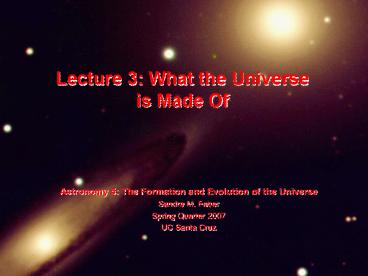Lecture 3: What the Universe is Made Of PowerPoint PPT Presentation
Title: Lecture 3: What the Universe is Made Of
1
Lecture 3 What the Universe is Made Of
- Astronomy 5 The Formation and Evolution of the
Universe - Sandra M. Faber
- Spring Quarter 2007
- UC Santa Cruz
2
Visible light is composed of different
wavelengths.Each wavelength is a different color.
3
The electromagnetic spectrum
4
Objects look different in different
wavelengthsDifferent wavelengths measure
different things
Can you guess what wavelength this picture was
taken at?
Hint blue is dim, yellow is bright
5
Part of an EM wave frozen in space and time
x
6
Animation 1Propagating EM wave
7
Rough structure of an atom
8
Electron energy levels (orbitals) within an atom
are quantized
9
To make an electron jump up, the incoming photon
has to have the right energy when the electron
falls down, the same energy photon is emitted
Atoms can interact only with photons of
particular wavelengths. This set of wavelengths
is its fingerprint.
10
Animation 2Absorption and emission of a photon
11
Emission-line spectra from glowing gases of
different elements
Hydrogen
Helium
Mercury
Uranium
12
The visible-light spectrum of the Sun is wrapped
here end to end from red to blue. The dark
lines are wavelengths that are absorbed by
atoms in the Suns outer layers.
There are millions of lines in the Suns
spectrum.
The strengths of the lines are related to the
number of atoms of each element.
Modeling these features allows us to measure the
Suns composition.
13
Emission versus absorption spectra
14
Animation 3Emission vs. absorption spectrum
15
An emission and absorption spectrum side by side
Sun vs. glowing iron gas in laboratory. The
light from both has been passed through the same
apparatus.
The known iron wavelengths can be used to
calibrate the wavelengths of features in the
Suns spectrum.
16
Each element has its own spectral signature.
Nearly all the stable elements have been seen in
stellar spectra. This is how we know that the
rest of the Universe is made of the same stuff we
are.
17
A major recent discovery color bimodality
PowerShow.com is a leading presentation sharing website. It has millions of presentations already uploaded and available with 1,000s more being uploaded by its users every day. Whatever your area of interest, here you’ll be able to find and view presentations you’ll love and possibly download. And, best of all, it is completely free and easy to use.
You might even have a presentation you’d like to share with others. If so, just upload it to PowerShow.com. We’ll convert it to an HTML5 slideshow that includes all the media types you’ve already added: audio, video, music, pictures, animations and transition effects. Then you can share it with your target audience as well as PowerShow.com’s millions of monthly visitors. And, again, it’s all free.
About the Developers
PowerShow.com is brought to you by CrystalGraphics, the award-winning developer and market-leading publisher of rich-media enhancement products for presentations. Our product offerings include millions of PowerPoint templates, diagrams, animated 3D characters and more.

